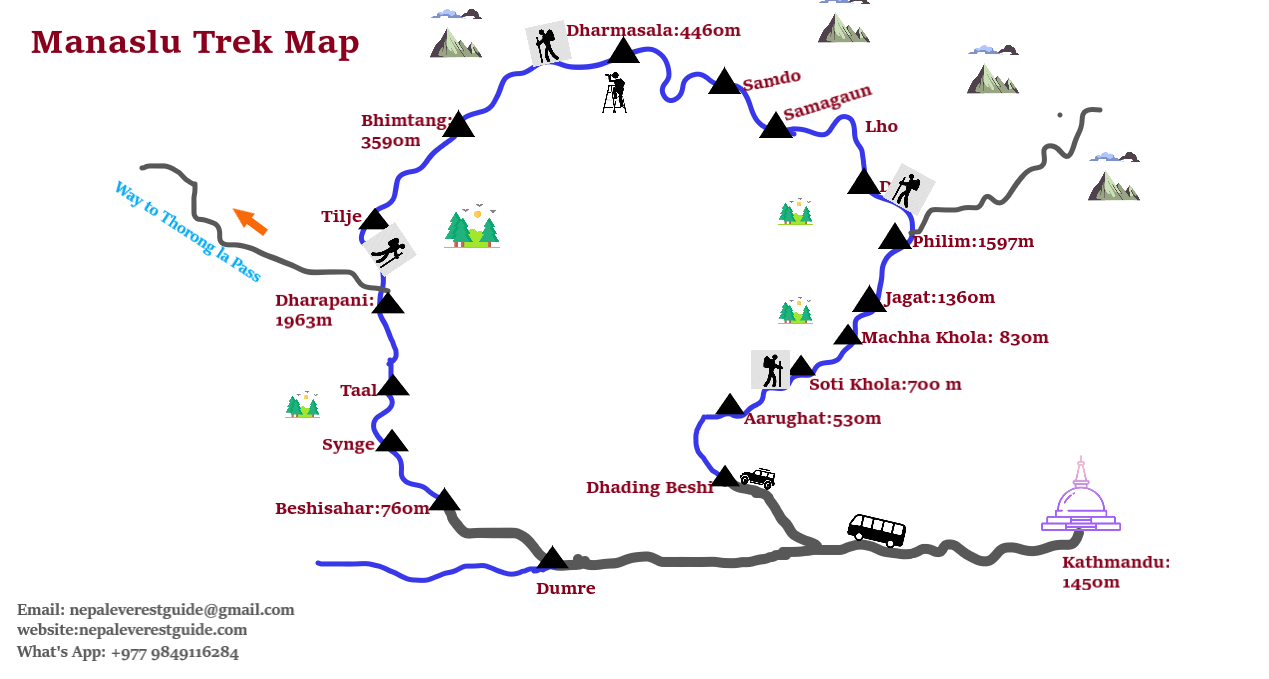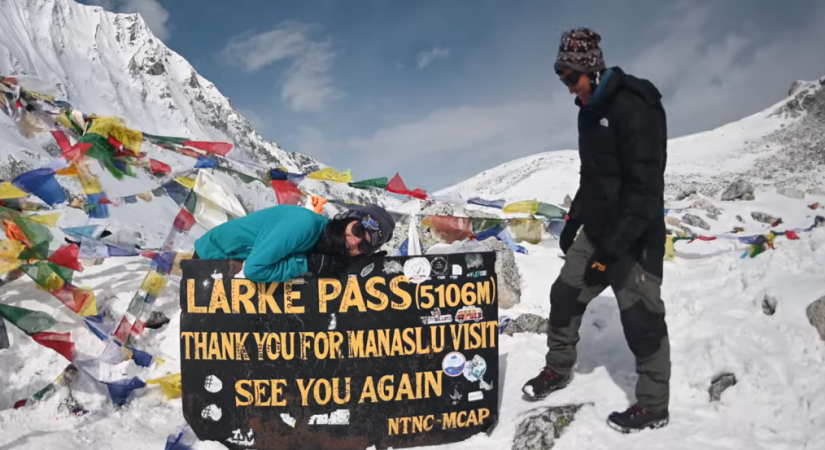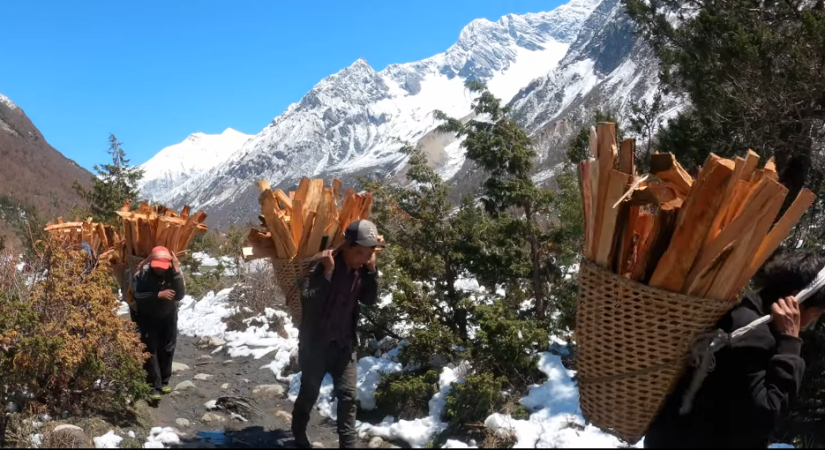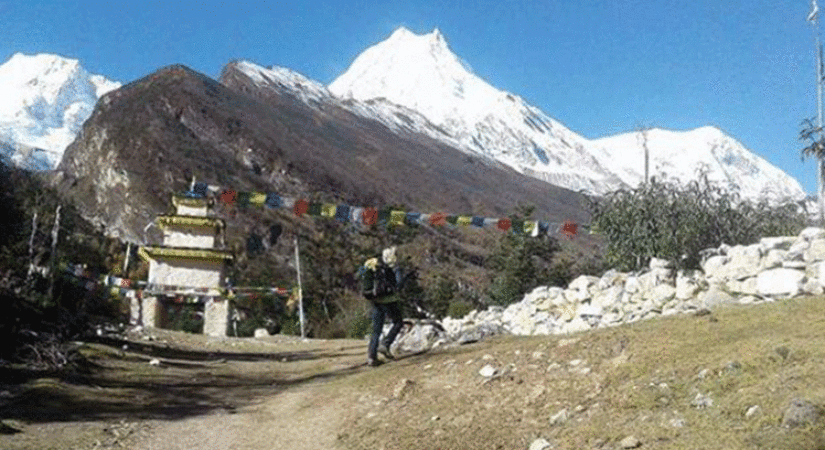KATHMANDU-MACHHAKHOLA-PHILIM-PHILIM-NAMRUNG-SAMAGAUN-SAMDO-DHARMASALA-DHARAPANI-KATHMANDU
Why 9N/10D Manaslu Trek?
- Stunning mountain views, including Mount Manaslu.
- Rich local culture of Gurung and Tibetan communities.
- Off-the-beaten-path trek through remote villages and lush forests.
- Diverse landscapes, from lowlands to glacial lakes and peaks.
- Challenging Larkya La Pass with breathtaking panoramas.
- Buddhist monasteries and historical sites.
- Unique flora and fauna.
- Warm hospitality of local people.
9N/10D Manaslu Trek Introduction:
The 9N/10D Manaslu Trek, lasting just 10 days, offers a perfect opportunity to explore the beautiful and rugged terrain of the Manaslu Conservation Area, which is a government-regulated zone. Just like in the Standard Manaslu Circuit Trek, trekkers must obtain special permits and hire guide-porters from government-registered trekking companies while trekking in this area.
The Short Manaslu Circuit Trek- 9N/10D Manaslu Trek is perfect for those who have good physical fitness and want to explore the Manaslu region but don't have the time for a longer trek. This short trek is suitable for small groups of a minimum of 2 persons, and it offers a chance to experience the beauty of the region in a short span of time.
One of the most appealing aspects of the Manaslu Short Trek is that it offers luxury transportation and lodges, along with guides and porters, which makes it a comfortable and adventurous experience. The trek includes the Larkya La Pass, which stands at an impressive 5160m and offers breathtaking views of the surrounding mountains.
The Manaslu Short Trek with Larkya- la pass is particularly well-suited for couples and smaller private groups. To ensure an authentic and enjoyable experience, Nepal Everest guide- (Freelancer guide)always assigns local guides from the same region.
In addition to the physical challenge of the trek, the Manaslu region is steeped in cultural and historical significance. The local people have unique customs and traditions, and trekkers can explore the ancient monasteries and remote villages that dot the region.
As responsible travelers, it's important to note that environmental conservation and sustainability are a top priority in the Manaslu region. Trekking companies and guides are actively working to preserve the natural beauty and biodiversity of the area, and trekkers can play a role in these efforts.
In summary, the Manaslu Short Trek is a perfect way to experience the beauty and adventure of the Manaslu region without committing to a longer trek. With luxury accommodations, experienced guides and porters, and stunning views, it's an experience that shouldn't be missed.
Manaslu Trekking Route
The Manaslu Short Trek takes you through a stunning route, starting with a jeep drive from Kathmandu to Lapubeshi and trekking to Machhikhola. The trek then continues through famous local villages like Jagat, Phelim, Namrung, Loh, Samagaon, Manaslu Base Camp, Smado, Dharamsala, Manaslu Base Camp, Larkya Pass (5106m), Bhimtang, and finally ends in Dharapani, which connects to the Annapurna Circuit Trek.
Nepal Everest guide offers multiple Manaslu Trek Packages for 2023 and 2024, including 14-day and 10-day itineraries for private lodge trekking. If you're interested in customizing your Short Manaslu Trekking package, please don't hesitate to get in touch with us. We'll be happy to work with you to create a customized itinerary that suits your needs and preferences.
Important information you should know before heading to Manaslu Region:
- The Manaslu Region is a restricted area, and trekkers need special permits.
- Private or sharing 4x4 jeeps can take trekkers to the starting point within 6 to 7 hours.
- The trek ends at Dharapani on the tenth day, and trekkers are driven back to Kathmandu via jeep.
- The Manaslu Trek costs depend on various factors, such as guide quality, transportation, lodges, food, and permits.
- Solo trekkers without guides or porters are not allowed to do the Manaslu Circuit Short Trek.
- The best seasons for the Manaslu Trek are March to May and September to December.
- The Manaslu Trek itinerary can be short or long, depending on the trekkers' preference.
- Trekkers get to see various attractions, such as rivers, rice fields, hanging bridges, local villages, and panoramic Himalayan views.
9N/10D Manaslu Trek Outline
Day 01: Drive from Kathmandu to Lapubeshi and trek to Machhikhola (710m/ 2328ft) 7 to 08 hours

What's included?
- Private transportation for airport pickup and drop-off
- Local bus transportation provided for trekking (private transport available for an additional cost)
- 2 nights of hotel accommodation in Kathmandu with breakfast included
- Bed and Breakfast during the trek,
- All necessary permits for Manaslu conservation area, Annapurna, and TIMS card
- Professional English-speaking Manaslu trekking guide with a license
- Emergency helicopter management
What's not included?
- Travel insurance,
- International and domestic airfare,
- Personal expenses such as alcoholic and cold drinks, laundry, etc.
- Nepal entry visa fee,
- Sightseeing tour and entrance fees to temples in Kathmandu and Pokhara,
- Lunch and dinner during your trek,
- Tips for guide and porter after the trek (highly expected).
- All Kind of drinks alchohalic and Non Alchohalic plus chocolates , desert etc.
Day by Day Itinerary
DAY
01
Drive from Kathmandu to Lapubeshi and trek to Machhikhola (710m/ 2328ft)
7 to 08 hours drive Breakfast, Lunch & Dinner Guest House
On the first day of the Manaslu short trek, we embark on a scenic 7-8 hour drive from Kathmandu to Lapubeshi. The journey treats us to picturesque countryside views, passing through charming towns and villages. Upon reaching Lapubeshi, the trek officially begins as we head towards Machhikhola. The trail initially descends to the Budi Gandaki River, crossed via a suspension bridge. We traverse quaint villages, terraced fields, and forests of rhododendron and pine trees. With mostly flat terrain and occasional steep sections, we encounter enchanting waterfalls before reaching our overnight stop in Philim. This day's trail offers a delightful blend of natural beauty and cultural immersion into the local way of life.
DAY
02
Machhakhola to Philim (1570ml5150ft)
06 to 07 hours Bfeakfast, Lunch & Dinner Guest House
The trek from Machhakhola to Philim takes approximately 6 to 7 hours and covers a distance of around 15 kilometers. The trek begins by crossing the Machhakhola River and walking through several small settlements. The trail then gradually ascends, passing through lush forests of pine, oak, and rhododendron. After a few hours of trekking, the trail descends to cross the Budhi Gandaki River and then ascends again to reach the village of Jagat, which is a permit checkpoint.
From Jagat, the trail continues through beautiful villages like Salleri, Sirdibas, and Gandruk, where you can enjoy stunning views of the surrounding mountains. The trail then crosses the Budhi Gandaki River once again and leads to the village of Philim. Along the way, you can see numerous waterfalls and streams, and the scenery is breathtaking. The village of Philim is known for its traditional architecture and is a great place to interact with the locals and learn about their culture.
DAY
03
Philim to Namrung (2660m/ 8730ft)
07 to 08 hours Bfeakfast, Lunch & Dinner Guest House
The trekking route from Philim to Namrung covers a distance of around 15 kilometers and takes approximately 7 to 8 hours. The trail follows the Budhi Gandaki River upstream and passes through several small settlements and dense forests of rhododendron and bamboo. Along the way, trekkers can enjoy the scenic views of waterfalls, suspension bridges, and the surrounding mountains. After reaching the village of Deng, the trail gradually climbs up to Namrung, passing through lush green forests and charming villages. Namrung is a small village with traditional houses, monasteries, and chortens. It is also a popular acclimatization spot for trekkers before heading towards the higher altitudes of the Manaslu region.
DAY
04
Namrung to Lho visit ancient Monasteries and stayovernight at Samagaun ( 3525m/11565ft)
07 to 08 hours Bfeakfast, Lunch & Dinner Guest House
On the fourth day of the Manaslu Short Trek, the trail leads from Namrung to Lho, where trekkers can visit ancient monasteries. These monasteries are known for their stunning architecture and intricate designs, and offer a glimpse into the rich cultural heritage of the region. After exploring the monasteries, trekkers continue on to Samagaun, where they will spend the night. Located at an altitude of 3525m/11565ft, Samagaun is a picturesque village that offers stunning views of the surrounding mountains. The village is also home to several lodges and guesthouses, where trekkers can rest and recharge before continuing on their journey. The trek from Namrung to Samagaun takes around 7 to 8 hours and covers a distance of approximately 18 kilometers.
DAY
05
Acclimatization day explore near by Places
4-5 Hours Bfeakfast, Lunch & Dinner Guest House
On the acclimatization day, trekkers can explore the nearby places in Samagaon. One of the popular destinations is the Manaslu Base Camp, which offers breathtaking views of the Manaslu mountain range. The trail to the base camp passes through beautiful forests and streams, and it usually takes around 6-7 hours to complete the round trip.
Another popular destination is the Birendra Tal, a glacial lake situated at an altitude of 3450 meters. The trail to the lake passes through scenic forests, and it usually takes around 3-4 hours to reach the lake. The lake offers panoramic views of the surrounding mountains, including the Manaslu peak.
Apart from these two destinations, trekkers can also explore the nearby monasteries and villages, where they can learn about the local culture and traditions. The acclimatization day is crucial for the trek as it allows the body to adjust to the high altitude, reducing the risk of altitude sickness.
DAY
06
Samgaun to Samdo ( 3700m/12139ft)
4 to 05 hours Bfeakfast, Lunch & Dinner Guest House
On day 6 of the Manaslu Short Trek, you'll start your trek from Samgaun and head towards Samdo, which is located at an altitude of 3700m/12139ft. The trekking trail starts with a descent through a dense forest of juniper and crosses a wooden bridge over the Budhi Gandaki River. From here, the trail begins to ascend gradually towards the village of Samdo.
As you trek towards Samdo, you'll come across breathtaking views of the Manaslu massif and other snow-capped peaks. Along the way, you'll also get to witness the traditional lifestyle and culture of the local people living in the remote Himalayan region.
After trekking for around 4 to 5 hours, you'll reach Samdo, a small Tibetan refugee village. The village is surrounded by mountains and offers stunning views of the Himalayas. You can spend the rest of the day exploring the village and interacting with the locals, who are known for their warm hospitality.
DAY
07
Samdo to Dharamsala (4460m/14629ft)
04 to 05 hours Bfeakfast, Lunch & Dinner Guest House
The trail from Samdo to Dharamsala is a challenging section of the Manaslu Short Trek. The trail begins with a steep ascent through a rocky terrain and crosses the suspension bridge over the Budi Gandaki River. The trail then follows a series of switchbacks through the dense forest of juniper and birch trees. As the trail gains altitude, the landscape becomes more barren and rugged. The trail continues to climb towards the Larkya La pass, with stunning views of the Manaslu range and surrounding peaks. Dharamsala is a small village that serves as a base camp for trekkers before crossing the Larkya La pass. The village offers basic lodges and campsites for trekkers to rest and acclimatize before the final ascent to the pass.
DAY
08
Dharamshala to Larkya la pass ( 5106m/16930ft then trek to Bhimtang (3700m/12201ft)
08 to 09 hours Bfeakfast, Lunch & Dinner Guest House
The trail from Dharamshala to Larkya La Pass is a challenging yet spectacular part of the Manaslu Short Trek. The trek begins with a steep ascent through the rocky terrain, which takes around three to four hours. As you climb higher, the landscapes change dramatically, offering panoramic views of snow-capped peaks, glaciers, and deep valleys. Upon reaching Larkya La Pass, you'll be rewarded with breathtaking views of the Himalayan range. The trail then descends steeply towards Bhimtang through lush forests of rhododendron and pine trees, crossing several streams and bridges. The trek to Bhimtang is an arduous eight to nine-hour journey, but the stunning mountain scenery and natural beauty make it a truly unforgettable experience.
DAY
09
Bhimtang to Dharapani (1920m/6300ft)
6 to 08 hours Breakfast, Lunch & Dinner Guest House
The trekking route from Bhimtang to Dharapani is the second last day of the Manaslu Short Trek, which takes approximately 6-7 hours. The trail from Bhimtang is a gradual descent through lush forests, passing through several small settlements along the way.
As you descend, you will cross the Dudh Khola river and enter a pine forest with beautiful views of the Manaslu range. You will also pass through small streams, waterfalls, and traditional villages with local houses made of stone and mud. The trail is well-maintained and easy to follow, with occasional steep sections and rocky terrain.
After crossing the river, you will walk through the beautiful Tilije village, which is a traditional Gurung village with a mix of Buddhist and Hindu cultures. You can take a short break and explore the village and its unique architecture, including the local chortens, mani walls, and prayer flags.
As you continue the trek, the trail gradually becomes wider and smoother, and you will pass through lush green forests of oak, rhododendron, and bamboo. The trail descends down to Dharapani, where you will be greeted by beautiful views of the surrounding landscapes and the Marsyangdi River.
From Dharapani, you can take a jeep drive to Besisahar and then another drive to Kathmandu, which marks the end of your memorable Manaslu Short Trek
DAY
10
Dharapani to Bashisahar and drive to Kathmandu
07 to 09 hours drive Breakfast & Lunch Hotel in Kathmandu
After completing the Manaslu Short Trek, trekkers will start their journey back to Kathmandu. The final leg of the journey involves a jeep drive from Dharapani to Besisahar, where trekkers can take some time to explore the town before continuing on to Kathmandu. The jeep ride is an exciting off-road adventure, providing a chance to soak in the scenic beauty of the region. From Besisahar, trekkers can take a local bus or private vehicle for the drive to Kathmandu. The journey back to the capital city takes about 6-7 hours, depending on traffic and road conditions. Along the way, trekkers can enjoy views of the stunning Himalayan landscapes, terraced farmland, and rural villages. The journey from Dharapani to Besisahar to Kathmandu is a perfect end to a memorable trekking experience in the Manaslu region.
Departure Dates
Sorry, No fixed departure dates are listed to group join, please request private trip
Looking for a group discount? Look no further! As an independent guide in Nepal, Nepal Everest Guide is pleased to offer a special price for groups of 10 or more. Contact us now to take advantage of this offer and make your trekking experience even more affordable.
Reviews
Danny Villogas
Belgium
An Exceptional Expedition: The Unique Elements that Made My 9N/10D Manaslu Trek
oct, 2021I completed the 9N/10D Manaslu Trek with Safe Holiday Adventure in Nepal, and it was an unforgettable experience. Throughout the trek, the planning was expertly done, and our guide and porter were highly knowledgeable and supportive. The professionalism and attention to detail shown by Safe Holiday Adventure’s staff were impressive.
The trek was both challenging and gratifying, and the stunning scenery left me awestruck. From the snow-capped mountain peaks to the lush forests and valleys, every moment of the trek was a sensory delight. The accommodations were clean and comfortable, and the food was appetizing and fulfilling.
I highly recommend Safe Holiday Adventure to anyone seeking a trek in Nepal. The company’s staff are experienced, amicable, and devoted to ensuring their clients’ safety and satisfaction. I express my gratitude to the Safe Holiday Adventure team for a remarkable 13-day trek.
Namaste NEPAL!!!
Danny
Essential Information
Kathmandu to Aarughat then to Lapubeshi - Transport Option
There are two options to travel from Kathmandu to Lapubeshi for the Manaslu Trek.
Public transportation: From Kathmandu, take a local bus to Arughat, which takes around 7-8 hours. Then, take another public jeep or bus to Lapubeshi, which takes around 2-3 hours.
Private transportation: You can also hire a private jeep or car from Kathmandu to Arughat, which takes around 6-7 hours. Then, take another private jeep or hire a local porter to reach Lapubeshi, which takes around 2-3 hours.
Soti khola and machha khola distance from Kathmandu
The distance from Kathmandu to Soti Khola is approximately 142 kilometers (88 miles) by road. The distance from Soti Khola to Machha Khola is approximately 14 kilometers (8.7 miles) by trekking trail.
Manaslu trek trails difficulties
The Manaslu Short Trek is considered a moderate to challenging trek. The trail includes steep ascents and descents, rocky terrain, narrow and steep paths, and crossing several suspension bridges over rivers. Altitude sickness can also be a potential risk. Therefore, trekkers should be physically fit and mentally prepared for the trek. Some of the most challenging sections of the trek include the ascent to Larkya La Pass, which is the highest point of the trek, and the descent towards Bimthang. Overall, the trek requires a good level of fitness and stamina, and trekkers are advised to acclimatize properly to avoid altitude sickness.
Why manaslu trek is popular?
Manaslu trek is popular among trekkers due to its remote and off-the-beaten-path nature, as well as its stunning natural beauty and cultural richness. It offers a unique opportunity to trek in a region that has been relatively untouched by modernization and tourism, providing an authentic and immersive experience. The trek takes you through a diverse range of landscapes, from lush forests and terraced farmland to alpine pastures and high mountain passes. Additionally, trekkers have the chance to experience the local culture and traditions of the various ethnic groups inhabiting the region, including the Gurungs, Tibetans, and Tamangs.
What to explore at Acclimatization day in Manaslu trek
During the acclimatization day on the Manaslu Trek, trekkers can explore the local culture, traditions, and lifestyle of the people living in the region. Some of the places that can be visited on this day are:
- Samagaun village, which is home to the famous Birendra Tal Lake, Pungyen Gompa, and Manaslu Base Camp,
- Manaslu Base Camp, which offers panoramic views of the Manaslu range,
- Birendra Tal Lake, which is considered to be a sacred lake by the locals,
- Pungyen Gompa, which is a Buddhist monastery that is said to be over 400 years old,
- Manaslu Conservation Area Project (MCAP) office, where trekkers can learn about the conservation efforts in the region,
- Exploring these places not only helps in acclimatization but also provides a deeper insight into the local culture and natural beauty of the Manaslu region.
About Cash for Manaslu Trekking
It's recommended to carry some extra cash for unexpected expenses during the Manaslu trek. It's advisable to carry around $200 to $300 in cash as a backup, in case of any emergencies, as there might not be any ATMs or banks available during the trek. However, this amount can vary depending on your spending habits and the duration of your trek. It's also a good idea to carry some Nepali rupees, as some lodges and shops may only accept local currency.
Manaslu short trek FAQs
What is the Manaslu Trek?
The Manaslu Trek is a challenging trek in Nepal that circles around the eighth highest mountain in the world, Mt. Manaslu.
How long is the Manaslu Trek?
The trek is usually completed in 14-16 days.
What is the best time to do the Manaslu Trek?
The best time to do the Manaslu Trek is from September to November and from March to May.
How difficult is the Manaslu Trek?
The trek is considered moderately difficult and requires a good level of physical fitness and endurance.
Is a permit required for the Manaslu Trek?
Yes, a special permit is required to trek in the Manaslu Conservation Area.
How much does the permit cost?
The permit fee varies depending on the season, but it usually costs around USD 100-120.
Is a guide required for the Manaslu Trek?
Yes, a licensed guide is mandatory for the trek.
How much does a guide cost?
The cost of a guide varies depending on the season and level of experience, but it usually ranges from USD 20-25 per day.
How much does the Manaslu Trek cost?
The cost of the trek depends on various factors like the duration of the trek, the level of comfort, and the services provided. It usually costs around USD 1,500-2,000.
What is the highest point of the Manaslu Trek?
The highest point of the trek is the Larkya La Pass, which is at an altitude of 5,160 meters.
Is altitude sickness a concern on the Manaslu Trek?
Yes, altitude sickness is a concern and can affect trekkers above 3,000 meters. It is essential to acclimatize properly and stay hydrated.
What kind of accommodation is available on the trek?
Teahouses and lodges are available along the trekking route.
Is it possible to camp on the Manaslu Trek?
Yes, camping is possible, but it requires additional equipment and a larger support team.
What kind of food is available on the trek?
Teahouses and lodges offer a variety of local and western dishes like dal bhat, noodles, soup, and fried rice.
Is it safe to drink water on the trek?
It is recommended to drink only purified or boiled water to avoid waterborne diseases.
What kind of gear is required for the Manaslu Trek?
Warm clothing, sturdy trekking boots, a backpack, a sleeping bag, and a down jacket are essential gear for the trek.
What kind of transportation is available to reach the starting point of the trek?
Private vehicles or public buses are available from Kathmandu to Soti Khola, the starting point of the trek.
What kind of wildlife can be seen on the Manaslu Trek?
Himalayan Thar, Snow Leopard, Musk Deer, and various species of birds can be spotted on the trek.
What kind of cultural experiences can be had on the Manaslu Trek?
The trek offers a chance to interact with local communities and experience their culture and way of life.
Is it possible to combine the Manaslu Trek with other treks in Nepal?
Yes, the Manaslu Trek can be combined with the Tsum Valley Trek or the Annapurna Circuit Trek to create longer and more diverse trekking experiences.
Cancellation Note
- Free cancellation up to 60 days prior departure
- 30% of the total cost of the trip will be charged if cancelled between 60 to 30 days prior to departure date
- 60% of total cost of the trip will be charged if cancelled in between 30 to 14 days prior to departure date.
Web design & Developed by Wildstone Solution








